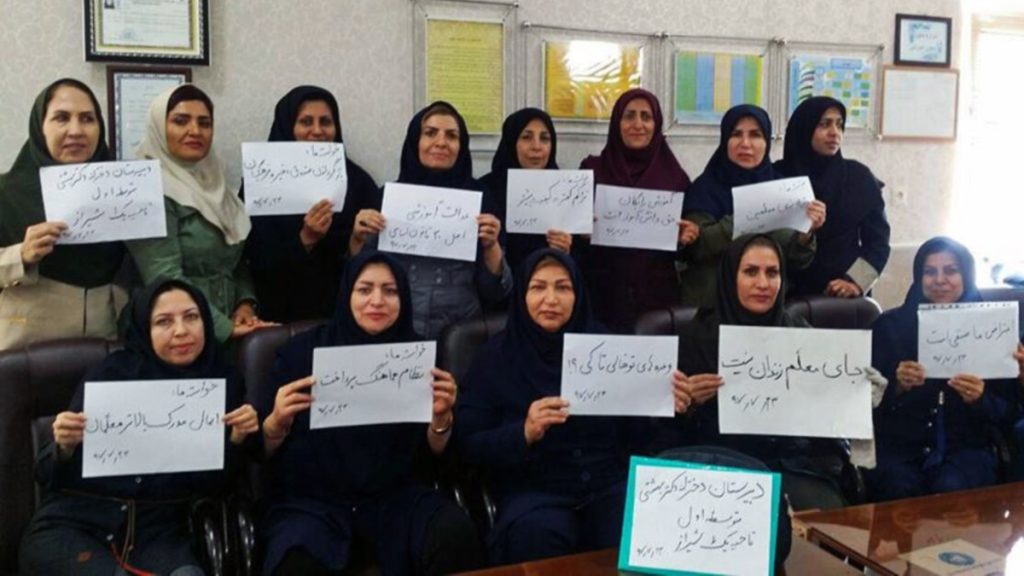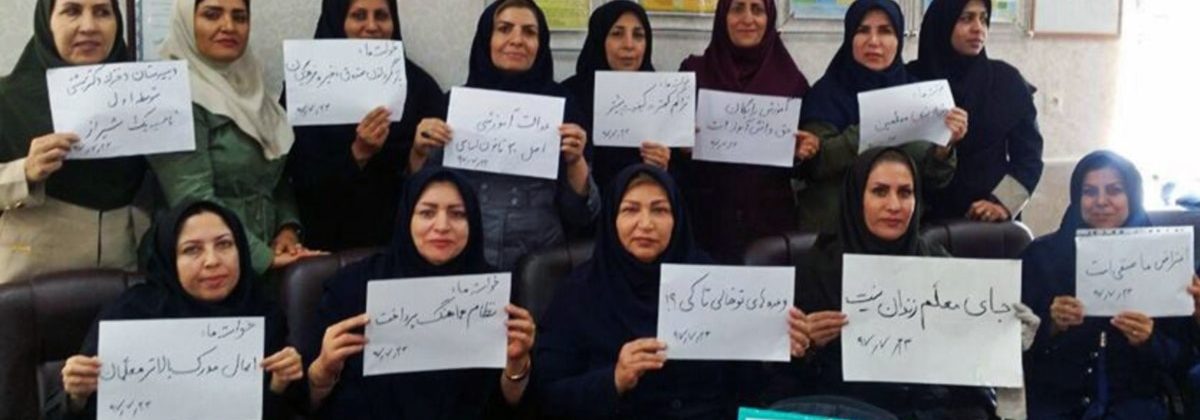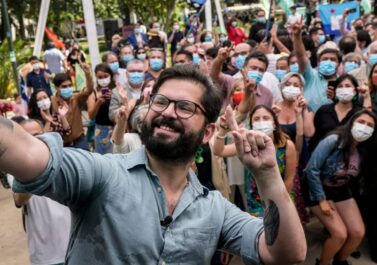
Shura: workers’ assembly/council. ‘Coordinating Shura’ in this context is the umbrella body of all the teachers’ associations across Iran. This article was written by comrades who arrived recently from Iran…
Teachers, students and other school staff started their second round of strikes [1] on the 19th February, 2022. According to various news channel reports, informal teachers’ reports, and data collection by ‘Coordinating Shura’, strikes have spread into more than 200 cities throughout Iran. While I am writing this short report (21st of February), teachers are preparing for a national demonstration on 22nd of February in front of parliament in Tehran and in front of the Ministry of Education buildings in other cities. Every wave of strikes and demonstrations is getting bigger and bigger: in 2018 teachers went on strike in less than 20 cities, in 2021 this number increased to 60 cities and later on more than 100 cities, and we expect that tomorrow’s demonstration will be held in more than 200 cities.
There are some reports from revolutionary activists that some cities that have been inactive during most of the industrial actions up until now, are turning into active bases for self-organisation of teachers and students. Now, Islamic Republic (IR) is encountering a major nationwide threat, a continuous and self-expanding movement of teachers and students. How has the teachers’ trade union movement, that before 2020 wasn’t able to expand in smaller cities, suddenly turn into a giant network of self-organisation of teachers on a national scale?
The beginning of the covid pandemic in 2020 started a new chapter in the self-organisation of teachers. One of the reasons is that, since all school classes turned online, mobiles and the internet have become central tools for teaching activity. The traditional concept of school, which was associated with real school buildings, blackboards, benches etc., has now been associated with various mobile applications and social networks. The covid pandemic forced teachers in smaller cities and villages, not only to learn how to work with online applications, but also to join the ever-increasing social network of teachers around the country. Now every teacher knows how to use proxy servers to break the internet censorship of IR and actively participate in Telegram groups comprising thousands of active teachers around the country discussing the next step of the struggle. ‘Coordinating Shura’ has used this opportunity very well, by providing online voting possibilities in the times of collective decision-making for the strikes and demonstrations.
The new chapter of self-organisation has some interesting features including:
– For the first time, informal (contracted) teachers, who work in very hard conditions have started their own national self-organised protests;
– Students are getting more and more involved in the teachers’ strike;
– Not all the protests and strikes are designed by ‘Coordinating Shura’. One can observe a regional rise of teachers in various parts of Iran, based on their own regional situation and local demands;
– The constellation of demands, proposed by ‘Coordinating Shura’ manifests the interests of not only teachers, but also the majority of pensioners, students and their families, and the whole working class population.
The Organisational Form of ‘Coordinating Shura’
‘Coordinating Shura’ comprises a) a General Assembly b) a Board of Directors c) a Board of Inspectors. The General Assembly includes delegates from all the ‘Associations of Teachers’ (Kanun-e-Senfi Moaleman) around the country. Each association has two delegates in the General Assembly and in each working group of the General Assembly. Only one delegate of each association has a vote. The Board of Directors is made up of seven elected associations of teachers, which lead the whole coordinating shura. The Board of Inspectors is made up of two delegates from associations of teachers that have the responsibility of producing reports for the General Assembly.
This organisational form, which is the typical form of a trade union, runs the risk of hitting limitations. [2] While the de jure leader of the strikes and demonstrations is the Board of Directors, the de facto leader and decision-maker is the General Assembly which, due to social network abilities, is constantly discussing and developing new ideas and decisions for the whole movement. Moreover, because the movement is incorporating students and their families into the everyday struggle of teachers, the ‘authority’ of the ‘coordinating shura’ is under the ‘influence’ of emerging neighbourhood shuras, workers’ shuras, revolutionary activists, and other players in civil society. On the one hand we have a formal, structured network of association of teachers, united under the emblem of ‘coordinating shura’, which is trying to negotiate with the IR (an impossible agenda). On the other hand, we have an informal, fluid network of working class shuras and activists that are organising people with the long-term perspective of overthrowing the IR (another impossible agenda under current conditions).
Moreover, the suppressive tactics of IR are bringing about new possibilities in the development of the teachers’ movement. In 2018, IR’s main tactic was suppression of the Board of Directors, in order to stop the strikes. This, in turn, gives the opportunity for the General Assembly to decide the actions based on the fluid decision-making of all of the delegates. Now, IR has shifted its attention to the delegates of associations and started to arrest those delegates. This, in turn, gives the opportunity to the collective body of associations and people who are outside the associations to decide about the next steps. The question is raised, is it really the Board of Directors that lead the teachers’ movement? Or do they follow the decisions of teachers, students and their families? What will come out of the internal contradictions of the organisational form of the ‘coordinating shura?’
The Educational Content of ‘Coordinating Shura’
Apart from the organisational form of ‘Coordinating Shura’ and ‘Teachers Associations’, the list of their demands is very interesting for the whole working class population around the country. ‘Coordinating Shura’ published an analytical statement at 28th December 2021, which showed their radical discursive shift from a trade unionist, economical discourse that was only concerned about teachers’ subsistence, into a revolutionary, politico-economic discourse, which calls for demands that cannot be realised under the current political economy of IR:
– More than 3 million students have been cast out from schools, due to lack of proper infrastructure for online education and the policy of commodification of education. Hence, the right to good quality and free education for all children is necessary.
– Teachers’ and pensioners’ wages are 50% below the poverty line and welfare and insurance facilities for them are very limited.
– The IR has banned teachers and other layers of society from creating their independent trade unions and associations. There is no right for demonstrations or strikes.
– Many teachers have been sacked or imprisoned due to political and trade union activities.
– The policy of ideologic (Islamic) education is self-defeating and we have to transform the educational system into critical education (which Mullahs have no place in!)
These issues are powerful enough to unite various sectors of society. The last issue in particular has become very popular, since it opens a channel for the rage of middle layers of working class people against the Mullahs and Islamic discourse.
Historical Perspective of the Self-Emancipation of the Iranian Working Class
Since the popular referendums of 2017 and 2019 (mass demonstrations in more than 150 cities in Iran), where the majority of Iranians shouted “No to IR”, spontaneous demonstrations, shuras, free associations, independent trade unions, political groups and militant circles are emerging in short periods of time. The legitimacy of IR has been completely melted down. However, the repressive apparatus of IR is still powerful and integrated. Moreover, the right wing, pro-west opposition is trying hard to recruit foot soldiers in order to control the situation if the IR would collapse.
While shuras in various industries or neighbourhoods are getting more organised and learning how to defend their immediate interests, the example of the teachers ‘coordinating shura’, is educating the masses in how to transcend immediate demands to form more general and popular demands that would turn more and more workers into active, militant workers. The experience of teachers shows us the power of self-organisation among specific layers of the working class on a national scale. However, this experience also shows us the weakness of the organisational form of the ‘coordinating shura’, which is unable to include associations of other intellectual workers (university teachers, psychologists, association of writers, social workers, etc.) and manual workers in other sectors of the economy. The self-emancipation of the working class in Iran goes through the creation of ‘coordinating shuras’. But, in the longer run, unification of these coordinating shuras will need the national collaboration of workers in different economic sectors.
Footnotes:
[1]
As far as I know, during the strike, teachers commit to not opening the online teaching application. In those areas where schools are not online, teachers commit to not go to classes. Students are informed to not come to school on strike days. So, although the school managers try to stop teachers from going on strike, or stop students from not being absent from classes, because most of the classes are online, it is hard for them to control the situation. However, as far as I know, there are scabs, teachers who don’t believe in the strike and try to continue their routine.
[2]
I am pointing here to the contradictory process of building a coordinating organisation, which is the inevitable next stage in developing a national body to link up all local shuras. There is a big risk of the coordinating body becoming detached from the local shuras, both in decision-making and interests.
There are also other issues to consider: while teachers are beginning to advance into more developed forms of self-organisation (gradually getting self-conscious of the limitations of their trade union-like form), oil workers are still dealing with building their trade union-like ‘coordinating shura’. While service workers, in some municipalities, have built their shuras successfully, workers in the health sector are less organised, and still dealing with the development of early forms of shuras in their workplaces.
So, we are witnessing a kind of ‘uneven and combined’ development’ of shuras in various layers of civil society, and I think all of them have the perspective of creating their trade union-like ‘coordinating shuras’ and then they will inevitably reach a stage where they will have to deal with the contradictory process of overcoming the limitations of these ‘coordinating shuras’.



